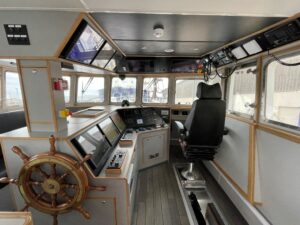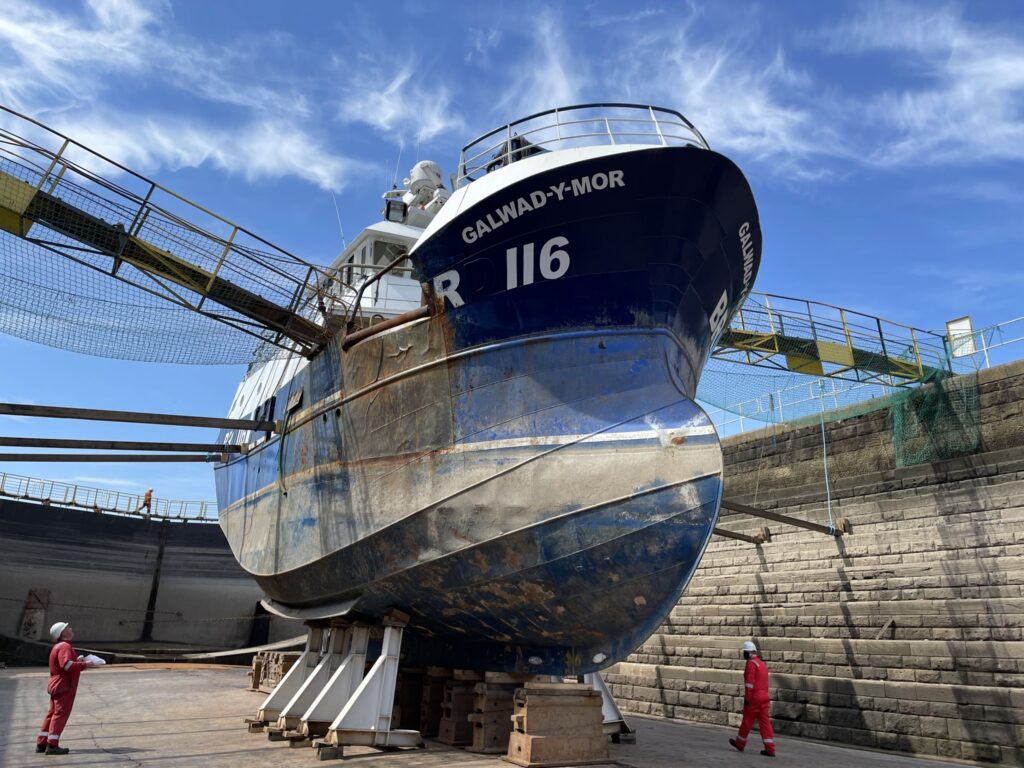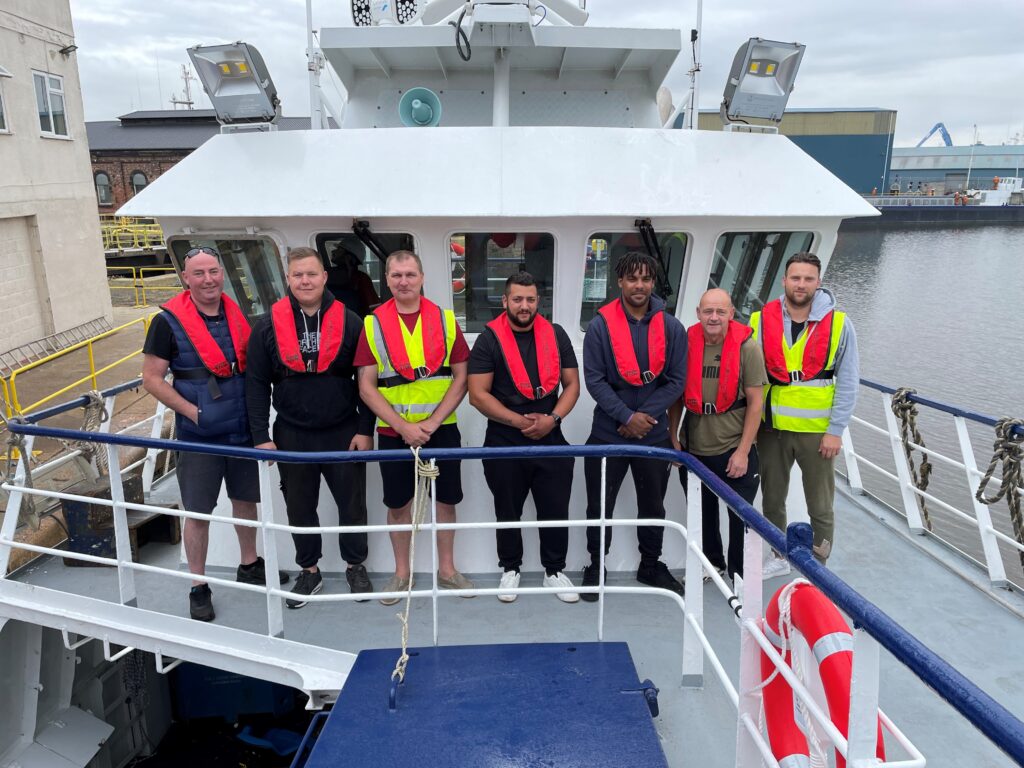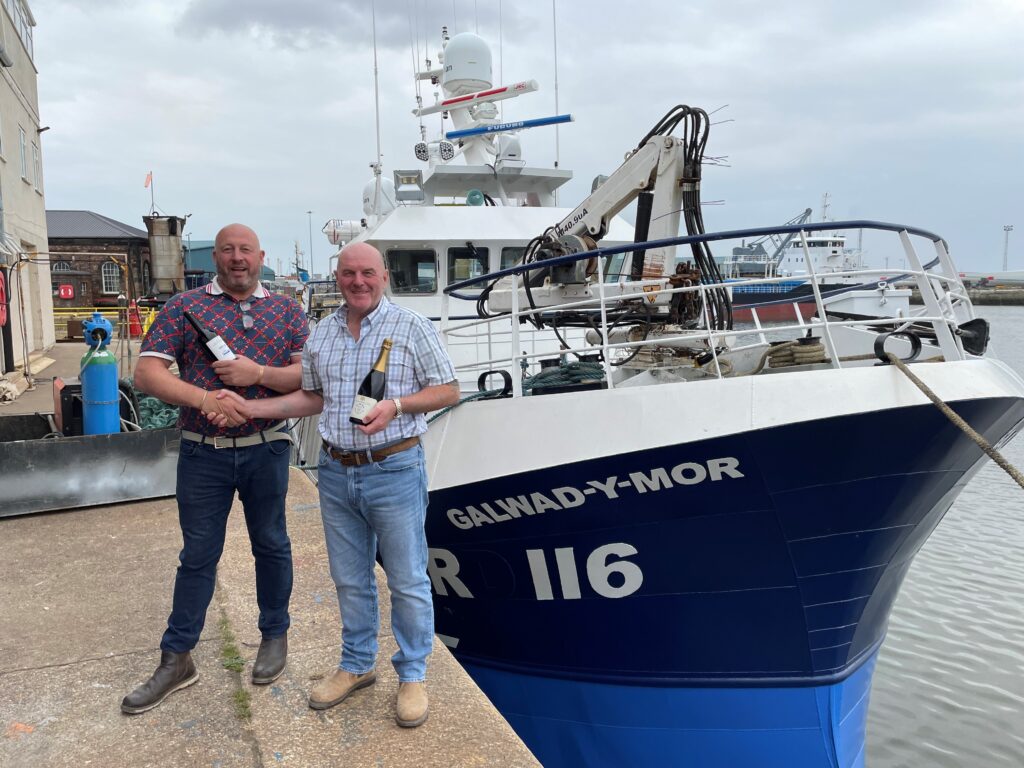The Rebuilt Galad-Y-Mor
PDF DownloadGalad-Y-Mor – Rebuilt after being severely damaged by a WW2 bomb exploding beneath the vessel.

At the end of August, the 15 metre (registered length 12.9m) crabber Galwad-Y-Mor left Alexandra Dock in Hull to commence fishing again after extensive rebuilding and refitting by MMS Ship Repair following an explosion at sea.
The vessel was built at the MMS Shipyard in Hull in 2007 for skipper / owner Iain Gray. The vessel has since worked successfully out of Grimsby until December 2020 when while hauling a string of pots 20miles North of Cromer in Norfolk, the crew became aware of a lot of strain on the back rope as though the gear had become snagged on the seabed.
Their string of pots became tangled round an underwater obstruction, what we now know to be a 250kg World War 2 bomb which exploded directly beneath the vessel in about 30metres of water. Before the skipper and crew could react, there was a huge underwater explosion creating a massive shock wave.

It is thought that the Galad -Y-Mor instantly dropped down about 20 feet into the ‘gas bubble’ created by the underwater explosion immediately below the vessel. As the gas bubble expanded and filled with water the vessel was very quickly thrown upwards about 6 metres before landing heavily back on the surface causing extensive damage to the vessel and badly injuring all the crew.
As the vessel started to settle lower in the water, the skipper although badly injured himself, immediately made a distress call on VHF channel 16, not sure that the distress call had been heard, he also notified other vessels in the area, and ordered the crew to launch the life raft and abandon ship. Before they could enter the liferaft they were rescued by an offshore support vessel that had been close by.
According to the MAIB Accident report, ‘’The damage experienced by a vessel from an underwater explosion is dependent on its proximity to the ordnance at the time of the explosion. In the case of a vessel striking a piece of ordnance such as a contact mine, the ensuing explosion causes direct damage to the hull in the form of a hole, and secondary damage to equipment from fragmentation of the mine casing and the vessel’s structure.
Damage caused by contact with ordnance usually includes flooding and the sinking of the vessel. A more distant underwater explosion of a piece of ordnance creates a gas bubble that rises to the surface, collapses, and is filled with seawater moving at high velocity, which creates a water plume jettisoned into the air. If the collapsing gas bubble interacts with a vessel’s hull, the energy from the in-rush of seawater can hole the hull or even break it apart.


Ordnance detonated on the seabed creates a shock wave that tends to exert hydraulic pressure to any nearby vessels on the surface, causing them to be thrown about. Damage may include pushing in of hull plating and displacement of equipment. In large explosions, nearby vessels can be thrown upwards out of the water, causing the unsupported hull to hog and then abruptly sag, which can result in a broken keel. It is common for people to hear more than one bang when a vessel encounters a single underwater explosion. This is due to reverberation of sound caused by the pulse bubble and shock wave.’’
The full MAIB report on the accident is available at https://www.gov.uk/maib-reports/subsea-explosion-resulting-in-damage-to-crab-potting-vessel-galwad-y-mor-and-injuries-to-crew
It makes interesting reading for any fisherman.
The report goes on to compliment the owner, skipper and crew for them all being familiar with the various safety requirements for the vessel. Such as all having the mandatory safety qualifications, undergone safety familiarisation and periodic training on board
Galwad-Y-Mor was crewed by a skipper, night watchman and five deckhands. The crew had worked together for several years and held the mandatory qualifications to work on a fishing vessel of this size. It is also worth saying that as well as having the mandatory qualifications, the crew had undergone regular safety familiarisation and periodic training on board Galwad-Y-Mor. Safety routines, such as man overboard, abandon ship and fire drills were carried out each month in accordance with the requirements of Merchant Shipping Notice (MSN) 1871.
This will have helped tremendously when the skipper and crew were faced with an abandon ship situation especially when some of them badly injured. At the time of the accident, all crew on the main deck were wearing automatic inflation PFDs and the two crew working around the hauling table were wearing hard hats. The main deck watertight doors to the accommodation and engine room and fish hold hatch cover were all closed as is standard practice when Galwad-Y-Mor was at sea.

Although extensively damaged after the explosion, flooded and lying very low in the water the Galad-Y-Mor remained afloat. It is almost certain that this is because the bulkheads either side of the engine room maintained their watertight integrity, containing the inrush of water.
Credit for the vessel remaining afloat after sustaining this horrendous explosion must go to Macduff Ship Design for the original design, and to Rob Langton and his team at MMS Shipbuilding in Hull who built the vessel in 2007. The MCA did comment that the vessel undoubtedly stayed afloat because the bulkheads didn’t breach which was a credit to both good workmanship and design
In the investigation into the cause of the explosion they recovered a metal fragment and traces of Trinitrotoluene (TNT) on both the metal fragment and the pot rope. After metallurgical examination of the metal fragment the investigators concluded that it was most likely that it came from a WW2 German SC250 bomb. These bombs contained about 123kg of explosive and were usually dropped from a German aircraft.
The stricken vessel remained afloat and was towed to Grimsby and after and after various surveys in Grimsby the vessel was towed across the Humber to MMS Shipyard for a complete re-build. Looking onboard the vessel the force of the explosion was so severe that the main engine ripped its engine foundations from the engine bed and ‘flew’ right up to hit the deck head before settling back in the bilge of the boat.
This sheared the various seawater inlets and discharge pipes from the hull allowing the seawater to flood the engine room. All the other machinery such as hydraulic power pack, gear box, genset, and several smaller pumps were similarly ripped from their mountings, ending up scattered around what was left of the engine room. The rudder actuator was displaced from the rudder stock. and the interior was total carnage. The wheelhouse equipment and wheelhouse linings were all ripped from their mountings and left scattered around the shell of a wheelhouse.
There was extensive damage throughout the rest of the vessel, the galley and mess deck, toilet and cabins all requiring rebuilding. Even the deck fittings did not escape with many broken pipefittings and broken light fittings. Some of those who went onboard to survey the vessel described the interior of the vessel as “total carnage”, saying it is amazing that there was no one onboard was fatally injured.
Once at MMS Ship Repair in Hull the boat was dry docked and literally stripped of everything on-board including every piece of machinery, electric components, cabin, galley and wheelhouse equipment. The damaged areas of hull plating which had suffered explosion damage were cropped off and replaced, this came to over 12 tonnes of shaped steel. Any misshapen steel components were cut out and replaced.

The full vessel was dry grit blasted to give a good surface preparation before being fully painted inside and out. A full new machinery package was re-installed comprising of a 483 HP Mitsubishi S6A3-MPTAW main engine coupled to a MIT Twin Disc gearbox driving a 1500mm four bladed propeller.
The skipper says that there is about a 2 knot increase in speed with the new engine, gearbox and propellor package. Electric power for the vessel is provided by a pair of 106KVA Boudouin 6W1055 generators. In the engine room are four electrically driven Desmi pumps, two large capacity for the Vivier tanks and two for bilge pumps and deckwash.
The Galwad-Y-Mor was completely re-wired with new control panels and up to date energy efficient equipment. The wheelhouse was completely rebuilt internally with all new electronic equipment supplied and fitted by SIRM. A new KAB wheelhouse chair on a sliding mount was also fitted. The foc’sle which is used as a crews working mess room was fully upgraded with washing machine, tea urn, sink unit, seating and an oil skin drying room. The forward bait room and vivier tank was grit blasted and re-coated.
The crew accommodation, down below aft, is well fitted out with a large a 6 berth cabin with many lockers, drawers etc for storage, as well as a single berth skippers cabin. The galley / mess room and wheelhouse layout were re-configured and fitted out to a very high standard as requested by skipper Iain Gray. Overall, the vessel was re-fitted out as good as new, if not better.

The boat is back at sea now still with original skipper, Lewis Mulhearn and several of the crew that were onboard at the time of the explosion. The vessel has also been reregistered to Bridgewater as BR 116. On completion the yard presented the owners with a second ‘build’ plaque for the wheelhouse and Rob Langton presented Iain Gray with a celebratory bottle of champagne.
In October Skipper Lewis Mulhearn was honoured for his part in the rescue of the crew by being presented with the Emile Robin Award by the Shipwrecked Mariners’ Society at its annual skill and gallantry awards at London’s Fishmongers’ Hall.
MMS Ship building is based in Hull’s Alexandra dock where they have two large drydocks capable of handling vessels up to 150 metres with a 6 metre draft, over 200metres of non-tidal deep water quay space as well as many workshops and a large 30 metre construction hall for new builds.
They have onsite a full range of inhouse trades. Over the years many UK fishing vessels have used their services, new builds such as Rebecca Janeen, Genesis Rose, Genesis enigma and the Galwad-Y-Mor while repairs and lengthenings range from Kirkella, Green Isle, Solstice, Marigold, Emulator, Success 111 and many more over the 30 years they have been based in Hull. They provide a one stop shop for all vessels owners with all services carried out by in house staff in their quayside workshops.

Telephone:
00353 (0)86 823 9608
(Editor)
00353 (0)86 840 1250
(Sales)
